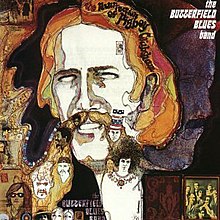The Resurrection of Pigboy Crabshaw
| The Resurrection of Pigboy Crabshaw | ||||
|---|---|---|---|---|
 | ||||
| Studio album by | ||||
| Released | December 1967 | |||
| Genre | Blues | |||
| Length | 44:29 | |||
| Label | Elektra | |||
| Producer | John Court | |||
| The Butterfield Blues Band chronology | ||||
| ||||
The Resurrection of Pigboy Crabshaw is a 1967 album by the Butterfield Blues Band, their third release. Its name refers to Elvin Bishop, whose role shifted to lead guitarist after Mike Bloomfield departed to form the Electric Flag.[a] The album marked a slight shift in the band's sound towards R&B and was the first Butterfield record to feature a horn section, which included alto saxophone player David Sanborn.[3]
The Resurrection of Pigboy Crabshaw generally received mixed to favorable reviews from critics, and reached number 52 in the American Billboard 200 charts in 1968.
Reception[]
| Review scores | |
|---|---|
| Source | Rating |
| AllMusic | |
| Rolling Stone | (mixed)[5] |
| New Rolling Stone Record Guide | |
| Record Mirror | |
| Uncut | |
Michael G. Nastos wrote in a review of The Resurrection of Pigboy Crabshaw at AllMusic that Paul Butterfield "really com[es] into his own" here with his vocals and harmonica, and the band are "as cohesive a unit as you'd find in this time period".[4] He described the closing track, "Tollin' Bells" as "somewhat psychedelic", adding that the guitar and the "slow, ringing, resonant keyboard evokes a haunting feeling." Overall Nastos called the album "likely the single best Butterfield album of this time period and you'd be well served to pick this one up."[4]
A 1968 review in Record Mirror stated that on this album the band's blues sound has "hardened" with "stronger" and "more confiden[t]" vocals.[7] The reviewer said the tracks' accompaniments are "clear and well recorded" with "clever" arrangements, although he preferred their own material to some of the covers they did, like "One More Heartache" and "Drivin' Wheel".[7]
In another review from 1968, Rolling Stone magazine felt that the band's newly acquired horn section is not fully utilized on this album and tends to "riff unobtrusively" in the background, letting Bishop's guitar and Butterfield's voice take the lead.[5] The solos are "short, though musically interesting", but often reduce to "mechanical-sounding, repetitive arrangements." The reviewer called "Drivin' Wheel" the album's "most successful" track, and concluded that while Resurrection "may not show the group to best advantage", they are "the most venturesome and exciting players of blues-based rock around".[5]
Track listing[]
| No. | Title | Writer(s) | Length |
|---|---|---|---|
| 1. | "One More Heartache" | Smokey Robinson, Marvin Tarplin, Robert Rogers, Ronald White, Warren Moore | 3:20 |
| 2. | "Driftin' and Driftin'" | Charles Brown, Johnny Moore, Eddie Williams | 9:09 |
| 3. | "I Pity the Fool" | Deadric Malone | 6:00 |
| 4. | "Born Under a Bad Sign" | William Bell, Booker T. Jones | 4:10 |
| No. | Title | Writer(s) | Length |
|---|---|---|---|
| 1. | "Run Out of Time" | Paul Butterfield, Gene Dinwiddie | 2:59 |
| 2. | "Double Trouble" | Otis Rush | 5:38 |
| 3. | "Drivin' Wheel" | Roosevelt Sykes | 5:34 |
| 4. | "Droppin' Out" | Butterfield, Tucker Zimmerman | 2:16 |
| 5. | "Tollin' Bells" | Willie Dixon; arranged by Butterfield Blues Band | 5:23 |
Personnel[]
- The Butterfield Blues Band
- Paul Butterfield – vocals, harmonica
- Elvin Bishop – guitar
- Mark Naftalin – keyboards
- Bugsy Maugh – bass, vocals on "Drivin' Wheel"
- Phil Wilson – drums
with:
- Gene Dinwiddie – tenor saxophone
- David Sanborn – alto saxophone
- Keith Johnson – trumpet
- Technical
- William S. Harvey – cover design, art direction
- Kim Whitesides – cover artwork
- Joel Brodsky – back cover photography
Charts[]
| Year | Chart | Position |
|---|---|---|
| 1968 | US Billboard 200 | 52[8] |
Notes[]
References[]
- ^ Beohm, Mike (March 16, 1988). "Blues Guitarist Bishop Sees End to Recording Drought". Los Angeles Times. sec. VI. p. 9. ISSN 0458-3035.

- ^ Deming, Mark. Elvin Bishop at AllMusic. Retrieved December 27, 2020.
- ^ Jump up to: a b "The Butterfield Blues Band – The Resurrection Of Pigboy Crabshaw". Uncut. August 1, 2004. ISSN 1368-0722. Retrieved December 26, 2020.
- ^ Jump up to: a b c Nastos, Michael G. The Resurrection of Pigboy Crabshaw at AllMusic. Retrieved December 8, 2020.
- ^ Jump up to: a b c "Records". Rolling Stone. New York City: Penske Media Corporation (5): 20. February 10, 1968. ISSN 0035-791X.
- ^ Marsh, Dave; Swenson, John, eds. (1983). New Rolling Stone Record Guide (2nd ed.). Random House/Rolling Stone Press. p. 73. ISBN 0-394-72107-1.
- ^ Jump up to: a b c Jones, Peter; Jopling, Norman (March 9, 1968). "New Albums from Manfred Mann, Judy Collins, Butterfield Blues Band et al". Record Mirror. ISSN 0144-5804. Retrieved December 26, 2020 – via Rock's Backpages.
- ^ "Chart History: The Paul Butterfield Blues Band". Billboard 200. Retrieved December 27, 2020.
External links[]
- 1967 albums
- Paul Butterfield Blues Band albums
- Elektra Records albums